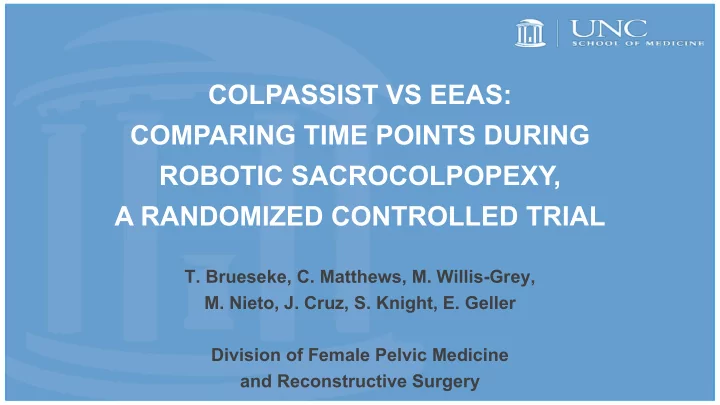

COLPASSIST VS EEAS: COMPARING TIME POINTS DURING ROBOTIC SACROCOLPOPEXY, A RANDOMIZED CONTROLLED TRIAL T. Brueseke, C. Matthews, M. Willis-Grey, M. Nieto, J. Cruz, S. Knight, E. Geller Division of Female Pelvic Medicine and Reconstructive Surgery
Disclosures • The Colpassist devices used in this study were provided by Boston Scientific as part of an unrestricted investigator- initiated grant • Catherine Matthews: – Boston Scientific: grant support and consultant – Johnson & Johnson: expert legal defense – Pelvalon: consultant
Background • Sacrocolpopexy is the gold standard surgical procedure for correction of vaginal vault prolapse 1 • Robotic assisted sacrocolpopexy (RSC) provides a minimally invasive approach but has been criticized for longer operative times 2 • Operative efficiency is key to minimize OR times and maintain patient safety 3 1 Maher Cochrane Database Syst Rev .2013;4(4) 2 Paraiso Obstet Gynecol . 2011;118(5):1005-1013 3 Geller J Minim Invasive Gynecol. 2013 20(1):43–8.
Background
Background
Background
Objectives • Primary objective : Compare operative time for RSC with Colpassist vs EEAS • Secondary objectives : Compare VAS satisfaction scores between Colpassist vs EEAS
Study Design • Single center, RCT, Jan 2015 to Nov 2017 • Consecutive patients scheduled for RSC • Inclusion criteria • >18 yo, planned RSC, prior hysterectomy, English speaking • Exclusion criteria • Prior sacrocolpopexy, pregnancy • Allocation stratified by surgeon • Randomized 1:1 (Colpassist : EEAS)
Sample Size Estimate • Published mean operative time: 44 ±10 min 1 • 20% difference in operating time deemed significant • 80% power, α = 0.05, ß = 0.2 • 25 women per group needed to detect a 9 minute difference in operating time 1 Geller, J Minim Invasive Gynecol . 2012, 20(1):43-48.
CONSORT Diagram Enrollment Assessed for eligibility (n=61) Excluded (n=9) ¨ Not meeting inclusion criteria (n=2) ¨ Declined to participate (n=4) ¨ Other reasons (n=3) Randomized (n=52) Allocation Allocated to Colpassist (n=25) Allocated to EEAS (n=27) Additional positioning device used (n=16) Additional positioning device used (n=0) Analysis Analysed Analysed - Intention to Treat (n=25) - Intention to Treat (n=27) - Actual Use (n=9) - Actual Use (n=43)
Demographics Colpassist™ EEAS (n=25) (n=27) Mean Age (years) ± SD 64±7 61±9 Race (white) 21 (84%) 20 (82%) Median CCI Score (IQR) 0 (0-1) 0 (0-1) Prior Hysterectomy Total 24 (96.0%) 25 (92.6%) Supracervical 1 (4.0%) 2 (7.4%) Prior Abdominal Surgery Other than 17 (68%) 12 (44.4%) Hysterectomy Prior Prolapse or Incontinence Surgery 12 (48%) 5 (22%) Mean BMI (kg/m 2 ) ± SD 27±5 29±5 Greatest Pelvic Organ Prolapse Stage Stage 2 8 (32%) 12 (44%) Stage 3 15 (60%) 15 (56%) Stage 4 2 (8%) 0 Data are n (%) unless specified
Primary Outcome Colpassist™ EEAS P value (n=25) (n=27) Total Time Using Vaginal Positioning Device 51 (41-77) 46 (29-60) 0.15 Anterior Vaginal Dissection Time 15 (10-18) 10 (8-15) 0.24 Posterior Vaginal Dissection Time 8 (5-12) 5 (4-8) 0.11 Anterior Vaginal Mesh Attachment Time 12 (10-16) 11 (7-15) 0.35 Posterior Vaginal Mesh Attachment Time 16 (11-20) 12 (8-18) 0.15 Data are formatted as: median minutes (interquartile range)
Actual Use Analysis Colpassist EEAS ¨ Intention to treat (n=25) ¨ Intention to treat (n=27) ¨ Actual Use (n=9) ¨ Actual Use (n=43) Colpassist™ EEAS P value (n=9) (n=43) Total Time Using Vaginal Positioning Device 53 (42-85) 46 (27-56) 0.56 Data are formatted as: median minutes (interquartile range)
Actual Use Analysis Colpassist EEAS ¨ Intention to treat (n=25) ¨ Intention to treat (n=27) ¨ Actual Use (n=9) ¨ Actual Use (n=43) Colpassist™ EEAS P value (n=9) (n=43) Total Time Using Vaginal Positioning Device 53 (42-85) 46 (27-56) 0.56 Data are formatted as: median minutes (interquartile range)
Surgeon and Fellow Satisfaction Scores Colpassist™ EEAS (Surgeons n=22) (Surgeons n=27) P value * (Fellows n=20) (Fellows n=22) Surgeon 19 (11-33) 63 (61-65) <0.01 How satisfied are you overall with the vaginal manipulator? Fellow 33 (24-45) 62 (53-65) <0.01 Vaginal Surgical Assistant Satisfaction Scores Colpassist™ EEAS P value * (n=24) (n=27) How satisfied are you overall with the 49 (31-58) 60 (50-65) 0.07 vaginal manipulator? Data are median VAS scores range 0-68 (interquartile range)
Surgeon and Fellow Satisfaction Scores Colpassist™ EEAS (Surgeons n=22) (Surgeons n=27) P value * (Fellows n=20) (Fellows n=22) Surgeon 19 (11-33) 63 (61-65) <0.01 How satisfied are you overall with the vaginal manipulator? Fellow 33 (24-45) 62 (53-65) <0.01 Vaginal Surgical Assistant Satisfaction Scores Colpassist™ EEAS P value * (n=24) (n=27) How satisfied are you overall with the 49 (31-58) 60 (50-65) 0.07 vaginal manipulator? Data are median VAS scores range 0-68 (interquartile range)
Additional Secondary Outcomes Colpassist™ EEAS P value (n=25) (n=27) Mean Estimated blood loss (mL) ± SD 52±37 50±29 0.95 Incidental Cystotomy 3 (12%) 1 (3.7%) 0.34 Incidental Vaginotomy 6 (24%) 5 (18.5%) 0.63 Data are n (%) unless specified
Strengths • Randomized controlled trial • Objective outcomes • Intent to treat design • Variation in surgical technique and suture type between surgeons
Limitations • Single academic center • No pre-study training on Colpassist • Cross-over rate to EEAS
Conclusions • No significant difference in operating time between Colpassist and EEAS, however, multiple Colpassist cases did use an additional positioning device • Surgeons and fellows overall more satisfied with EEAS • Vaginal surgical assistants were equally satisfied with Colpassist and EEAS
Implications • Surgical efficiency may not be strongly influenced by choice of positioning device • Surgeons should be aware of various options of positioning devices available and select one with the most desired characteristics (may vary based on patient anatomy) • Future research to optimize efficiency in RSC may include examination of additional intraoperative variables
COLPASSIST VS EEAS: COMPARING TIME POINTS DURING ROBOTIC SACROCOLPOPEXY, A RANDOMIZED CONTROLLED TRIAL T. Brueseke, C. Matthews, M. Willis-Grey, M. Nieto, J. Cruz, S. Knight, E. Geller Division of Female Pelvic Medicine and Reconstructive Surgery
Recommend
More recommend